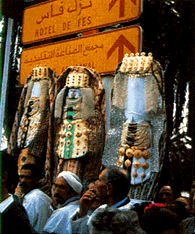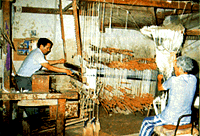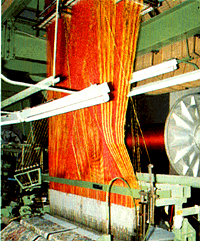
ZAWAJ.COM WEDDING STORIES
 STORIES
STORIES
The Threads of Time in Fez, Morocco
Three textile scholars record textile making traditions through the modern medium of video
By Louise W. Mackie
Louise Mackie was a curator in the Textile Department of the Royal Ontario Museum and project director of Threads of Time: Traditional Textiles in Fez Morocco.

|
Wedding costumes made from exquisite woven and embroidered fabrics are considered so important that they are paraded on poles during national holidays. Photography: L.W. Mackie |
This is the story about a project in which ancient techniques were explored and documented with the latest in video technology, a task that at times was propelled more by pure idealism than experience. The reward has been great, for a slice of living history is now preserved for posterity.
Through my research at the Royal Ontario Museum and a course in Lyon, France, I became increasingly fascinated with brocaded silks, textiles woven with exquisite and intricate patterns. Brocaded silks have been luxury items in Islamic and European cultures for centuries and I was curious to learn more about how they were made and used. Almost everywhere automation had completely supplanted the traditional handmade work. In Fez, Morocco, brocades are still created by hand on age-old draw looms, following a 1500-year old tradition. Fez provided the unique opportunity to discover what handmade-textile practices could reveal about this culture as well as other cultures where comparable practices no longer existed.
In 1986 I set off on my first trip to Fez. Names and addresses led to workshops where I stayed for hours, even days. I watched a brocaded "silk" (in fact rayon or polyester) being woven, centimetre by centimetre, on a huge drawloom operated by two skilled craftsmen. Slowly the luxurious old silks in the ROM and other museums took on new meaning. Clearly the workings of the ingenious drawloom, invented about 1000 years before the printing press and once considered as significant, had to be made more accessible to the public and scholars alike. But how? The answer was video. There was a sense of urgency because I realized that even in Fez the drawloom was threatened with extinction much like an endangered species of animal.

|
In Fez, the traditional drawloom and
its team of artisans are being replaced by the automated loom. Photography: L.W. Mackie |
Coincidentally, just after my return to Toronto, two textile scholars, Lotus Stack of the Minneapolis Institute of Arts, and Frieda Sorber of the Textielmuseum Vrieselhof, Oelegem-Ranst, Belgium, happened to visit the ROM. Lotus Stack had made a short video about a Chinese drawloom, and both she and Frieda Sorber were riveted by the prospect of documenting the creation and use of brocaded silks in Fez for the benefit of future generations. We became a team, aided by Mark Stanley, who had produced videos about textiles with Stack in Minneapolis.
In 1987 we travelled to Morocco to define our project and to make contacts with officials and craftspeople. As in many cultures the finest handmade fabrics are worn and displayed at weddings, and thus fabrics associated with weddings became the focus for our project. When we returned in 1989 and 1990 we were joined by Susan S. Davis, an anthropologist who had been conducting fieldwork in a village near Fez and who had even taught embroidery, and by two invaluable translators-cum-consultants, Amal Bennani Benghazi of Fez and Leila Abouzeid of Rabat.
Fez is a city of contrasts where old traditions and new practices are constantly evolving and being integrated into daily life. Only in Fez can one examine a variety of sophisticated handmade fabrics once typical of urban cultures and find that the manufacture and use of these textiles is still vital. The reasons for this rare combination of dynamic traditional and modern textile manufacture are geographic, political, religious, and economic. Founded in A.D. 789, Fez lies on two rivers amidst rolling hills. It was the former political capital and today thrives as the cultural and handicraft capital of Morocco.
Because many Fezi are directly involved with handicrafts (or at least their parents were) they are knowledgeable consumers who can easily judge the quality of a product. They appreciate the skills, artistry, and time required to make textiles, and are willing,when able, to pay substantial sums for them. In contrast, western tourists usually lack trained eyes. Their purchases of inferior products, in the opinion of many local businessmen, have caused some decline in quality dating back to at least the 1930s, as some craftsmen cater to tourists' tastes.
During our 1989 trip to Fez we conducted fieldwork, and in 1990, with the entire team, we achieved our goals by videotaping textiles associated with weddings and by interviewing craftspeople, merchants, and consumers. Documented textiles were purchased for future exhibitions.
Weddings vary in length; we taped a four-day celebration, which included a party where the new home was completely furnished in only a few hours, a henna party to decorate the bride's hands, a wedding reception hosted by the bride's parents and another hosted by the parents of the groom. Many Fezi brides prepare seven to 10 elegant outfits to wear during the celebrations. Neggafa (wedding consultants) provide the distinctive Fezi wedding costume, which is so important culturally that it is paraded on poles on national holidays. Both the long wedding head-shawl and the kaftan are still woven by hand on drawlooms.
Drawlooms are sophisticated machines. They are operated by a weaver who is responsible for the fabric's structure, and by a drawboy who sits at the side of the loom and is responsible for the design. The two men work sequentially and efficiently to accomplish the slow, precise, labour-intensive job. They take four hours to weave one metre of the fashionable behja (crown) design used for covering divans in Moroccan salons. The more colours in a pattern the longer it takes to weave because each colour is interlaced separately.

|
Automated looms, like this one can weave
in minutes the same amount of the popular behja design that would
take hours to produce on a drawloom. Photography: L.W. Mackie |
Patterns are tied onto drawlooms, a precise process that requires hours or days or even weeks to complete. Yet once a design is tied on the drawloom, it can be easily retrieved. In this sense the ancient drawloom is like a computer. But the memory of the drawloom is limited, and large patterns that are not in use must be detached and stored. When the patterns are needed again, it only takes two to three hours to reattach them.
Abdelkader Ourregli, a drawloom owner and weaver, prices his handwoven yardage competitively with the yardage woven in mere minutes on the automated modern looms of Ben Cherif, the renowned Fez manufacturer of furnishing fabric who makes his product look as much like the handwoven fabrics as possible. Only experts can detect the difference.
The fashionable behja design provides historical and cultural insights. It is based on French silks woven in Lyon specifically for the Moroccan market as part of a group of fabrics known as "Textiles for the Orient." They were exported by the 1920s or perhaps even earlier and were enormously popular in Fez. One lab technician told us that she was buying 86 metres of the behja design to furnish her salon because it's traditional. We in Morocco realize now that traditional things have more value than modern ones."
One fashion that was popular in the 1960s, and that has been of longstanding interest to textile curators at the ROM, follows an ancient custom. Kaftans were woven on drawlooms as piece goods. Using six pattern programs, the front, back, and two sleeves were woven sequentially for tailoring into one garment. The length of the garment is predetermined because the fancy bottom border can not be shortened.
Weaving elaborately patterned fabrics is only one of several
kinds of handmade textile manufacture in Fez; there is also embroidery,
and several different types of embroidery are prominent at weddings.
Unlike weaving, which requires considerable equipment and space
and is generally done by men, embroidery occupies thousands of
skilled Fezi women from all walks of life, who require only minimal
equipment -a needle, thread, ground fabric, and embroidery frame.
Traditionally, young girls were taught embroidery by a family
member, and they would start with items for their trousseaus.
Although some girls still practise this custom, the greater educational
opportunities for girls today leave them less time for such pursuits.
Brides can purchase ready-made embroidery; however, the finest
quality must be ordered months, even a year, in advance.
Fez-stitch embroidery is the oldest and the most culturally significant,
as well as the most durable, difficult, time-consuming, and expensive.
Its designs, which comprise geometric and plant shapes in one
to seven colours, are renowned in Morocco and abroad. Fez-stitch
embroidery is formed by a reversible counted-thread stitch, often
associated with cross-stitch. Modern brides prepare or order
tablecloths with matching napkins and topsheets with matching
pillowcases, items that became fashionable in the 1950s as a
result of the French occupation (1912-1956). Partially fuelled
by regional pride, Fez-stitch embroidery is experiencing a revival.
Motivation is the key to learning the Fez stitch, according to Mme Rabea El Mernissi, who has been teaching it since the 1950s. In the three-year curriculum, students learn by making motifs, starting with the simplest and building to the most complex. they start with (the equivalent of ) letters, then do sentences," explains Mme El Mernissi. In the process, samplers are made that graduates can use for reference and for showing to customers who wish to choose specific motifs.
No motifs are drawn on the cloth as guidelines. The embroiderers must count the number of threads that each stitch goes over and under, and given the process, the speed at which they work is astounding.
Commissioned embroideries are usually ordered directly from embroiderers, which permits customers to select colours and designs. Prices are based on the quality of the ground fabric, the number of colours, the number of skeins of embroidery thread used, and the time that will be required. A topsheet with a double border and four pillowcases, needing about 170 skeins of thread, costs about $240 and can take anywhere from three months to three years of constant work to complete. A more realistic estimate for a bedsheet set or a tablecloth set is about eight months.
Imitations of Fez-stitch embroidery abound on textiles, paper, and plastic, which confirms its cultural importance. The most surprising imitations are woven, produced since at least the 1920s. This contradicts the widespread practice of embroidery imitating woven textiles. The woven imitations are intended primarily as cushion and divan covers in traditional Moroccan salons. Their existence came about for purely economic reasons; woven imitations of Fezstitch embroidery take a fraction of the time to make and cost little in comparison to their highly esteemed models.
Another type of embroidery, goldthread, is also widely associated
with Fez. It was the chief export item early in this century
and still is a thriving industry. Clothing items such as slippers,
belts, circumcision suits, kaftans, and, of course, items associated
with weddings may display gold-thread embroidery.
When the bride's hands are decorated with henna at a wedding
party, a special gold-thread-embroidered velvet henna set is
used. The set includes such traditional items as the mendil,
a large rectangular piece placed on the bride's lap; two pillows
on which she rests her arms; and mitts to protect her decorated
hands. A recent addition is an embroidered tissue-box cover-an
example of traditions that are constantly evolving in subtle
ways. At weddings the bride is paraded during the reception in
a domed canopy, elaborately decorated with gold thread. She and
her groom, both wearing traditional costumes, are also raised
in trays, decorated with gold thread, by strong neggafa so that
all the guests may admire and applaud them, while lively music
is played.
Gold-thread embroidery is constantly changing. About 1930 real gold thread was replaced by low-grade "gold" thread and silk velvet was eventually replaced by synthetic fibres. Some high-quality, ready-made, goldthread-embroidered items are available in specialty stores, although most fine work must be ordered. Consumers may choose their own motifs, but certain motifs are associated with specific functions. For example, peacocks are currently popular for wedding items. However, good artisans can make any design. With the aid of a magnifying glass Lahcen Moussaid copied the ROM logo from a piece of stationery onto yellow paper templates for embroiderers to cover with gold thread.
While gold-thread embroidery is quickly learned, it takes time to master. The embroiderer keeps the gold thread on top of paper templates, secured by a plain thread that is brought up from underneath.This is called underside couching. The best embroiderers are well known and are given more difficult designs such as calligraphy, where long lines must be maintained. One painter, Ahmed Benhayia, who currently designs calligraphy, gives equal credit to the embroiderer for her skills.
A third type of embroidery,produced by sewing machine, is now the most common and the most innovative. For example,one clever woman copied the embroidery design on an Egyptian singer's robe while she watched her on television, a splendid example of electronic design transmission. As with Fez-and gold-stitch embroidery, the finest items are usually com missioned and can take from weeks to months to produce.
These impressive and varied techniques of weaving and embroidery, and the people and places associated with them,were captured on videotapes that are now being edited to a 30 minute program for general audiences and for teaching purposes, and to detailed programs for specialists. Research and fieldwork are always carried out to find answers to specific questions, and sometimes the results provide information well beyond what was anticipated. This certainly applies to the work in Fez, and it has strengthened our belief that, at present, the documentation of threatened traditional practices-the context for so much material culture-is more important for future generations than our study of existing collections that are properly conserved and safely stored.
This article is reproduced from the website
of the Royal Ontario Museum. See their website for
more information on this subject and this article.